Supermassive black holes sat at the centre of active galaxies could have company. Binary pairs of these titanic cosmic objects could merge to form an even more monstrous black hole. Observational methods are finally becoming sensitive enough to spot such an event.
The image of a supermassive black hole sat monolithic and alone at the centre of its galaxy, mercilessly swallowing any matter unfortunately enough to cross its path could be seriously challenged over the coming years. Theories of how galaxies grow and evolve and the role supermassive black holes play in these processes have long suggested that these objects may not dwell alone. In fact, not only may such spacetime events live in pairs, but after being brought together, they may merge in what could be the most powerful single event in the Universe, profoundly affecting its evolution.

“Astrophysical black holes are among the most fascinating objects in the Universe: they are ideal laboratories to study the fundamental laws of physics and one of the main drivers of the evolution of the Universe,” explains Alessandra De Rosa, a research astrophysicist at the National Institute of Astrophysics, Roma, Italy. “Understanding how they work and interact with their close environment, and unveil the physical conditions of the medium around them is one of the major challenges of 21st-century Astrophysics.”
Understanding the relationship between black holes and the galaxies that host them is key to building a model that satisfactorily describes the evolution of both. But, thus far evidence of this process is sparse. So, why are supermassive black hole mergers so hard to spot?
Hidden in Plain Sight. How Supermassive Black Hole Binaries and Mergers evade Observation
Despite the potential power of such a merger event, we haven’t as of yet managed to distinguish individual binary supermassive black holes or much evidence that such collisions occur. This is because these pairings and the mergers that may eventually arise from them lurk in what is known as the Active Galactic Nuclei (AGN) — compact regions at the centre of galaxies where the electromagnetic emissions dwarf that of the entire galaxy which surrounds it.
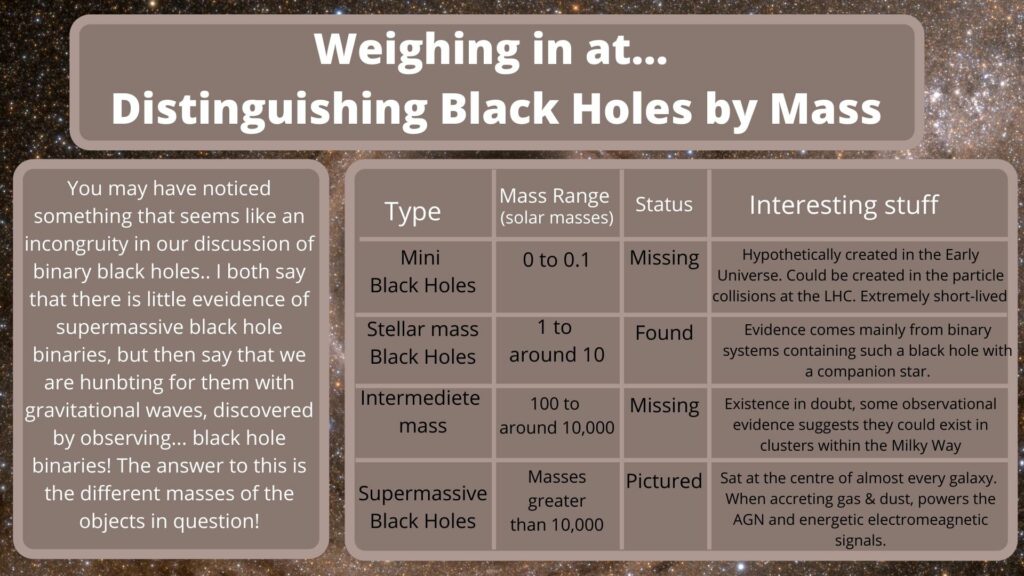
Because this emission — which occurs from the radio wave to the gamma-ray regions of the electromagnetic spectrum — is so powerful, astronomers believe that it does not arise as a result of stellar activity. Rather, they theorise that the powerful electromagnetic radiation emitted by the AGN is the result of at least one supermassive black hole accreting matter — a violent process in which dust, gas, and even stars are ripped apart in a violent and tremendously hot accretion disc surrounding a central supermassive black hole before falling onto what can roughly be described as its ‘surface.’
Here’s the problem; that electromagnetic emission is so overwhelmingly powerful and the AGN is so small in comparion to its host galaxy that there is no way that traditional astronomy — which relies on electromagnetic signals — alone, can distinguish the finer detail of this region. Finer detail that could reveal occupation by two, rather than just one, supermassive black holes.
“Currently, observational evidence for these pairs is almost non-existent,” De Rosa laments. “This can be explained if they quickly shrink to small separations and become impossible to be resolved with telescopes as pairs. So, we must rely on indirect signatures.”
Fortunately, supermassive black hole mergers, if they occur, would not just be prodigious producers of electromagnetic radiation. They should also produce intense gravitational wave signals.
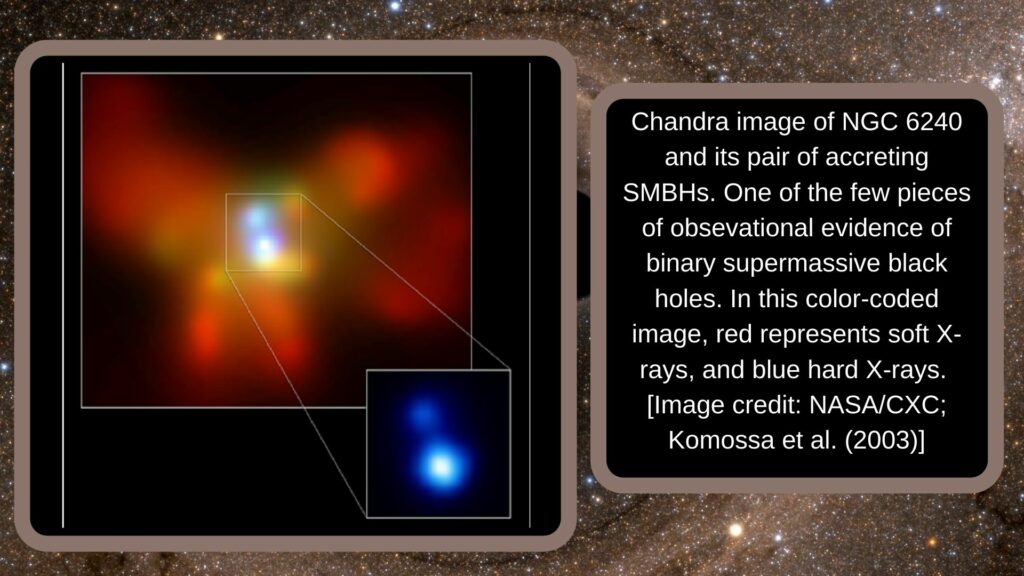
De Rosa is the lead author of a review paper published in the journal New Astronomy Reviews that looks both the history of our search for supermassive black hole binaries and puts forward a road map for future discovery of such events. The researcher emphasises the importance of ‘multimessenger astronomy’ — which combines traditional electromagnetic observations with the detection of gravitational waves, allowing astronomers to view the Universe in an entirely new way, thus making events and objects are previously hidden to them — events like black hole mergers — accessible.
But before examing mergers, it’s worth considering the truly epic processes that bring supermassive black hole pairings together in the first place.
Cosmic Matchmaking: Bringing Together Supermassive Black Holes
It may not be too surprising to find supermassive black holes hanging-out together in pairs, as our observations of the Universe thus far, show that stellar objects seem to prefer to hang out in pairs. These binary systems are far more common than single star systems such as our solar system, and three-star systems — the latter of which prove to be far too unstable.
“A binary supermassive black hole is made up of two supermassive black holes that are orbiting around each other,” says Julie Comerford, an Associate Professor in the Department of Astrophysical and Planetary Sciences at the University of Colorado, Boulder who specializes in the study of AGNs. “Such binary systems are common in the universe — around half of all stars are in binary systems, where two stars are orbiting around each other.”
As black holes evolve from such stellar objects, and these objects enjoy the company, it would seem intuitive to believe that black hole binaries should be fairly common. There’s a problem with that thinking though.
Only the most massive stars end their lives as black holes, and supermassive black holes are even rarer. Couple that with the fact that most binary systems contain a massive star coupled with a much smaller counterpart. Thus, It’s quite unlikely that two stars in the same binary system would both end up as supermassive black holes. In fact, after the transformation of the first star, it’s likely its partner will be stripped of material and left as a neutron star, a much smaller white dwarf, or destroyed entirely– possibly consumed by its counterpart.
So, if supermassive binaries aren’t likely to grow together, this means that some event must create this union– the merger of two galaxies.
“Each massive galaxy has a supermassive black hole at its centre, so the way you make a supermassive black hole binary is by merging two galaxies together,” Comerford tells ZME Science. “Each galaxy brings its own supermassive black hole to the merger, and as the galaxies combine the supermassive black holes begin their own dance of orbiting around each other.”
This means that spotting such a supermassive black hole binary would provide good evidence that the galaxy it occupies is the result of a merger, or even, that such a merger is still ongoing. It would also give us a hint at what is to come for our own galaxy. “This will one day happen to our Milky Way Galaxy — when it merges with the Andromeda Galaxy in about 4 billion years,” Comerford continues. “Our supermassive black hole and Andromeda’s supermassive black hole will form a binary!”
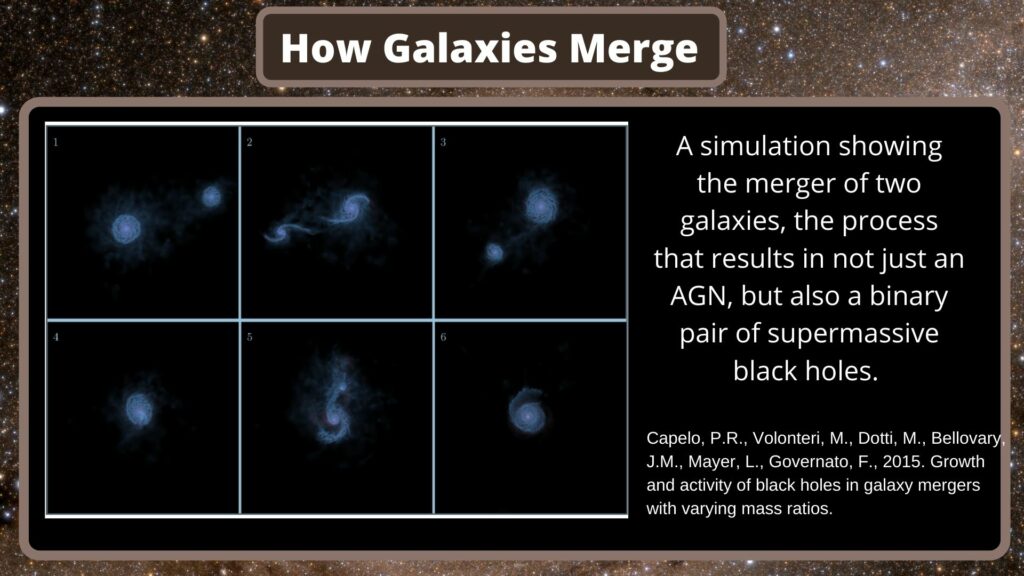
Mathematical modelling of these galaxy mergers seems to show that the process causes major gas inflow towards the central supermassive black hole — or black holes, as the case may be — this powers accretion and various nuclear processes activating the galactic nucleus. This inflow of gas, dust and other material could also result in the growth of the supermassive black hole.
“Astronomers believe that galaxies merge one or more times during their cosmological life,” says Alessandra De Rosa, who is is a research astrophysicist at the National Institute of Astrophysics, Roma, Italy. “These gigantic collisions are likely to be the primary process by which supermassive black holes are activated.”
Thus, galactic mergers aren’t just responsible for bringing supermassive black holes together, they also could kick start the feeding frenzy that makes an AGN the source of incredibly powerful radiation.
But what happens when these binary pairs of supermassive black holes form? Do they remain in a binary, or do they combine to form an even larger supermassive black hole? The merger of supermassive black holes to form larger objects would explain certainly one lingering cosmological question; how did these objects grow to such tremendous sizes in such a short period of time?
Despite the convenience of this phenomenon to tie up some loose cosmic-ends, we still don’t really know if it’s happening or not.
Using Gravitational Waves to Shed Light on Black Hole Binaries
After being brought together by a galaxy merger, when the supermassive black holes are very small separations, the gravitational waves that they emit carry away energy and enable the black holes to merge.
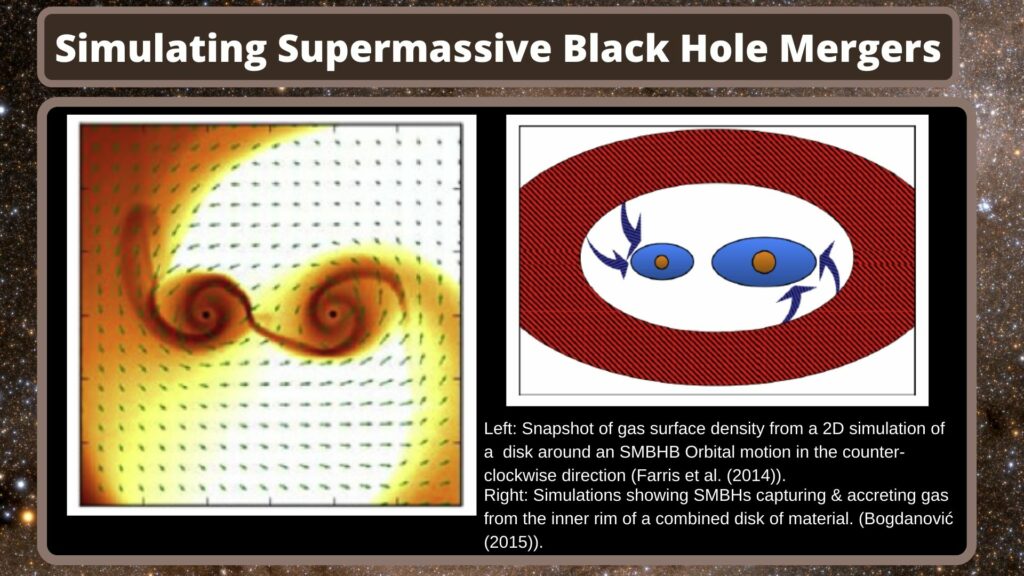
Thus, supermassive black holes at the centre of each galaxy are dragged close to each other, and eventually, form what is known as a dual active galactic nucleus. Theoretically, the final stage of this coming together — particularly if the black holes are gravitationally bound — will be the coalescence of these monsters in a merger that results in an even larger supermassive black hole. This merger would be accompanied by the emission of a gravitational-wave signal. Signals that thanks to the Laser Interferometer Gravitational-Wave Observatory LIGO, and its upcoming space-based counterpart Laser Interferometer Space Antenna (LISA), we can now theoretically detect.
“We think that binary supermassive black holes ultimately merge with each other and produce very energetic gravitational waves. In fact, supermassive black hole mergers are second only to the Big Bang as the most energetic phenomena in the Universe,” Comerford explains. The problem is, that even LIGO — responsible for the first detection of gravitational waves from colliding stellar-mass black holes — isn’t yet capable of detecting gravitational waves from merging supermassive black hole.
“These gravitational waves are too high frequency to be detected by LIGO, so they have not yet been detected,” Comerford adds. “But, we expect that pulsar timing arrays will detect gravitational waves from supermassive black hole mergers for the first time in just a few years.”
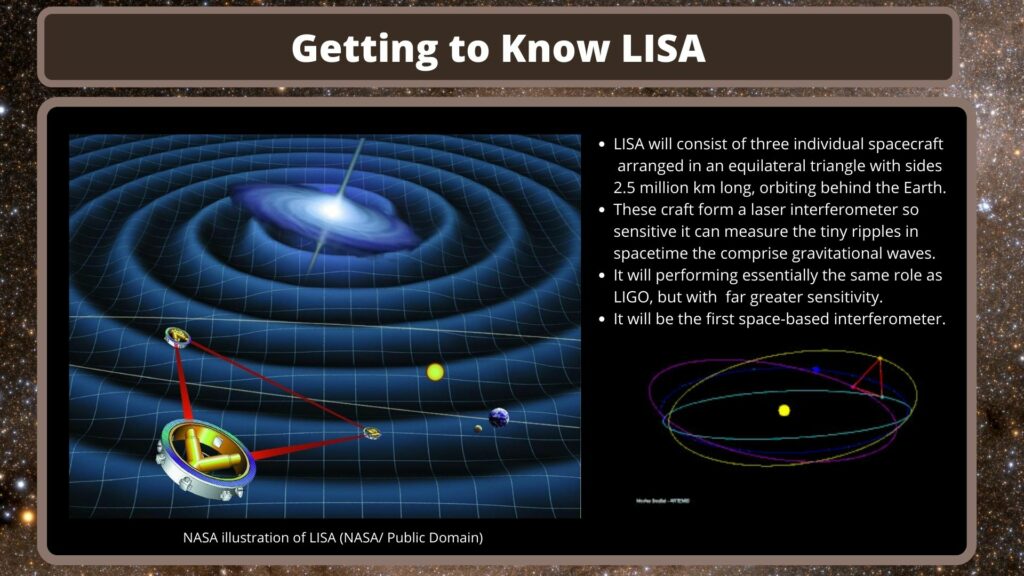
De Rosa concurs with the possible breakthrough in detecting gravitational waves from supermassive black hole mergers, highlighting not just the future contribution of pulsar timing arrays, but also, that of LISA — a space-based laser interferometer set to launch in 2034. “In the next decades, space-borne gravitational wave observatories, such as the next large mission of the European Space Agency, LISA, and experiments such as the Pulsar Timing Arrays, will provide first direct evidence of binary and merging SMBHs in the Universe,” she explains.
For Comerford, the breakthrough new gravitational wave detection methods and multi-messenger astronomy stand poised to answer fundamental questions that have influenced her entire career. “When I was a graduate student, my group found some intriguing galaxy spectra that we thought might be produced by supermassive black hole pairs. I wondered if these unusual spectra could be the key to finding supermassive black hole binaries. I’ve been working on new and better ways to find supermassive black hole pairs ever since,” the researcher concludes.
“I think the shocking thing is that we don’t actually know if supermassive black hole binaries merge! It could be that they just circle around each other and are not able to get close enough to each other where the gravitational waves can take over and make them merge.
“When we detect gravitational waves from supermassive black holes, that will be the first time that we actually know that supermassive black hole binaries do merge.”
Sources and Further Reading
De Rosa. A, Vignali. C, Bogdanovic. T, et al, ‘The Quest for Dual and Binary Supermassive Black Holes: A Multi-messenger View,” New Astronomy Reviews, [2020].


